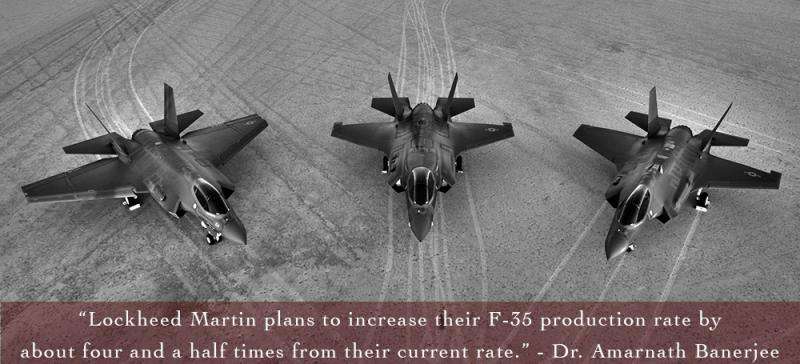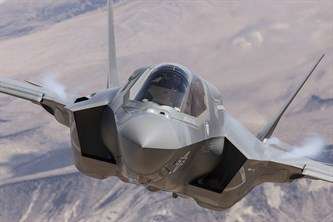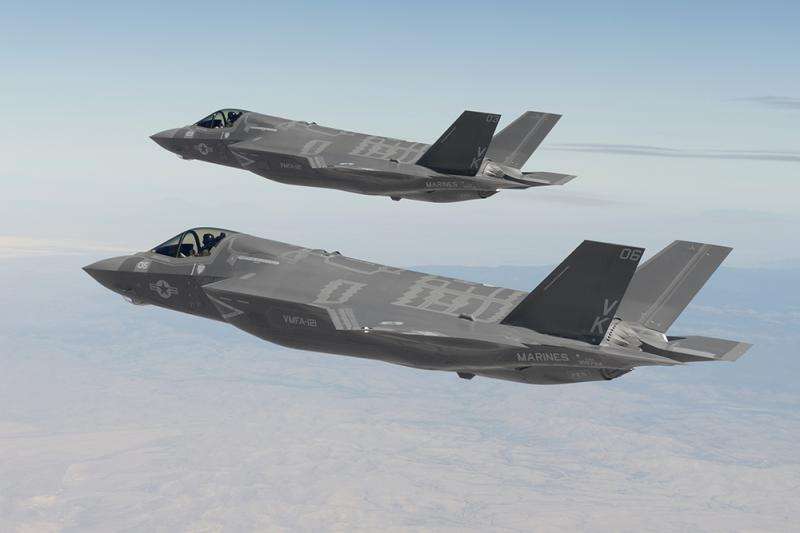Soaring to faster production

Preparing for the take off of faster production, Lockheed Martin and the Department of Industrial and Systems Engineering at Texas A&M University are investigating the use of advanced industrial engineering tools and procedures to study F-35 rate production.
"The main focus of the Texas A&M study is the many integrated processes that must be optimized and balanced as the production line of F-35 aircraft ramps up production to meet the customer's demand," said Dr. Lewis Ntaimo, an associate professor and the Marilyn and L. David Black Faculty Fellow in industrial and systems engineering.
Ntaimo and Dr. Amarnath Banerjee, with the help of graduate students Ashley Owenby and Ryan Hillegass, are modeling and analyzing the process of assembling an F-35 aircraft at the Lockheed Martin facility.
"Lockheed Martin is responsible for putting the final aircraft together," said Banerjee, professor and the Corrie and Jim Furber '64 Faculty Fellow in the department. "One company builds the engine, another company builds the seat and so on. Our job is to model the mating of the four fuselage sections followed by the final assembly stations. Modeling these assembly processes with real-world probability distributions will help us understand the critical process elements and potential bottlenecks as production rates increase."
Lockheed Martin has already developed the plans to implement the increased production rate, but is open to new techniques that may identify improvements in the current plan.
"Lockheed Martin plans to increase their F-35 production rate by about four and a half times from their current rate," Banerjee said. "The plan is to increase the production rate in stages over the next few quarters."
After visiting the facility, the team of researchers began collaborating on how to go about studying the complex F-35 manufacturing systems and identifying the processes that should become more efficient as production rates increase. The application of advanced industrial engineering simulation techniques was of particular interest to Lockheed Martin.

"In order to do this, as industrial engineers, we have to understand the processes," Ntaimo said. "Once we understand the process, we capture and model it. Then we build simulation models that allow us to actually run the process to see how long it takes to get an aircraft out."
While every plan works perfectly in theory, a complex manufacturing system like the F-35 must be able to deal with unanticipated quality, material or engineering issues as they arise.
"One such variable is that some jobs that are supposed to be done in a given station, due to engineering, quality, personnel or material issues, do not always get finished on time resulting in out of station work," Banerjee said. "Out of station work typically costs more to complete when it is moved out of its original position on the assembly line. So, there are buffers in the models to allow for the crews to catch up. When there is unfinished work, they have to figure out what crew to allocate to the job, the level of the unfinished work, and who can perform the job. When people are reassigned, the work rotation becomes non-standard and thus a disruption to the line."
Ideally, the buffers should not have any work and should only serve as holding stations, which would indicate no out of station work. The F-35 is a mixed-model production line—producing three variants on the same line—which was one of the advantages of the original joint strike fighter affordability strategy. In spite of the shared learning and commonality between variants, the changeover between them does result in some variability in the system.
"When there is a shift in production from one variant to another, disruption occurs from the differences in tasks required to assemble another variant," Banerjee said.
Additionally, not all of the variants are produced in equal numbers. When a variant is produced in smaller numbers, the production staff is not as familiar with all the steps.
The team is analyzing different types of data including future production plans and proposed increases in production staff to handle the growing production rate.

"It is a learning process," Banerjee said. "The more they make a particular variant, the better they get at it."
The team is first building simulation models that will accurately replicate the results currently seen on the Lockheed Martin production line.
"We use simulation to see the extent of the variabilities, look at the schedules, which transitions are happening, and when they are occurring," Banerjee said. "Once we know if this works, we will then apply optimization techniques to help efficiently increase the assembly of the planes."
"The optimization problem will involve determining the appropriate levels of decision variables for the production line to meet the desired production schedule for each type of aircraft," Ntaimo said. "In addition to optimizing the schedules, we want to help Lockheed Martin minimize the risk of missing any internal scheduled dates. If they miss these deadlines, then they may incur additional costs."
Brent Lyon, president of the industrial and systems engineering advisory council and Lockheed Martin industrial engineering senior manager, is looking forward to executing the future plans of the company as it increases the F-35 production rates.
"By bringing in outside eyes with this level of expertise in analytics and optimization, we can assure that as we execute our future plans for increasing production rates that we will do so at the most efficient and effective level," Lyon said.
Provided by Texas A&M University




















